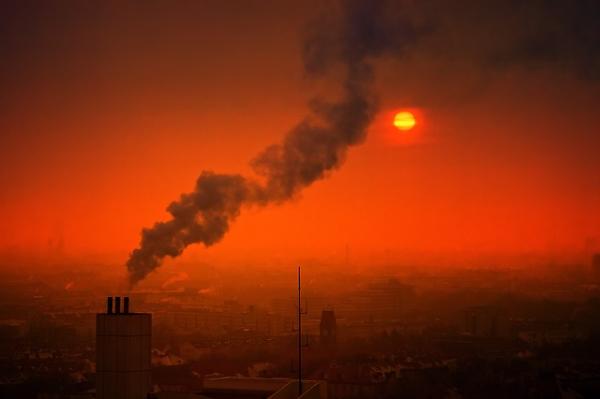In the Beginning.
1952 was a Dickensian winter in a Britain still recovering from World War II. The unusual cold meant more household coal burnt for heat; London's air stagnated from a warmer layer atop colder surface air, creating  dense fog and noxious air pollution. Visibility dropped to near zero, animals died, and cinema projections couldn't reach the screen. Over the next four days, 4,000 people died from the pollution, and an estimated 100,000 were sickened. New York City suffered similar stagnations in 1953 and 1962, and Los Angeles had severe smog problems in the 1950s.
dense fog and noxious air pollution. Visibility dropped to near zero, animals died, and cinema projections couldn't reach the screen. Over the next four days, 4,000 people died from the pollution, and an estimated 100,000 were sickened. New York City suffered similar stagnations in 1953 and 1962, and Los Angeles had severe smog problems in the 1950s.
Those events led to Clean Air Acts in the U.K., and the U.S. New methods to control emissions were developed, and monitors were deployed throughout the nation to determine progress in meeting regulatory standards. Ambient air quality improved dramatically. For example, sulfur dioxide concentrations dropped by 90% in New York City, and the particulate matter cut by up to a factor of 4 in many locations.
How clean is clean enough; should we now declare victory;? Despite these real advances, the press reports global estimates of 7 million premature deaths associated with air pollution, half of which may due to indoor household sources.
Mind the Gaps.
The 1970 U.S. Clean Air Act created the EPA and mandated ambient air quality standards that would protect public health with an "adequate margin of safety." Today, the EPA's monitoring focuses on compliance with those standards, but accountability research to quantify resulting public health benefits has been lacking. EPA epidemiology has emphasized premature mortality associated with any of the six pollutants designated as harmful in 1970. Several additional issues have surfaced more recently.
Pollution sources: There are unregulated sources that emit both monitored and non-monitored pollutants directly into our breathing zones, the most common of which are indoors and include environmental tobacco smoke. Who knows what evils may lurk indoors where we spend 90% of our time? In much of the country, the air we breathe may now be cleaner outdoors than indoors. Nicola Twilley [2] recently reported on air pollution experiments in domestic kitchens noting, "Outdoor air has been regulated for decades, but emissions from daily domestic activities may be more dangerous than anyone imagined." EPA does not monitor indoor air quality because it's challenging to accomplish and not required by the Clean Air Act. Indoor air quality is affected by infiltrated outdoor air pollution and follows the same time cycles within a city, albeit at reduced concentration levels. Pollution from indoor sources varies substantially from house to house depending on personal habits, season, building construction, presence of pets, etc. Indoor and individual exposures (which are seldom measured) are only weakly correlated with the outdoor data used to estimate health effects. Bottom line: the average outdoor air quality in a city cannot represent individual exposures of inhabitants.
Pollutants: Additional harmful pollutants beyond the six identified after the 1970 Clean Air Act have since been identified but are not routinely monitored. They include possibly carcinogenic toxic metals, ultra-fine particles that can enter the bloodstream [3], and black soot like the harmful particles in London's 1952 fog. Research on these pollutants is hindered because they may be difficult to measure and have not been systematically monitored nationwide. Some pollutants are monitored but not harmful at current levels, and others are harmful but not monitored. It's high time to divorce public health research from regulatory convenience.
Health outcomes: Epidemiology is concerned with the underlying causes of disease with which premature mortality may be only loosely connected. Lives are never "saved" or "lost"; they may be extended or curtailed. Such changes should be reported rather than body counts; current studies indicate that the increments range from days to months but not years. The bases of EPA's cost-benefit analyses should be changed from cost per premature death to time-based values.
Fluctuations in daily mortality counts represent susceptible (usually elderly) individuals pushed over the brink as demonstrated by autopsies of the London fog victims. Any of several environmental perturbations, including heatwaves, could be involved, and those frail individuals most at risk are usually indoors in different environments. Defining "safe" air quality as required by the Clean Air Act is problematic given the variable susceptibility of the elderly from day-to-day and the need for daily air quality data that are rarely available due to monitoring costs.
Annual average mortality rates have been linked with chronic disease rates, but confirming autopsies have not been done. Some studies have interpreted such associations as causal, conclusions that are seldom warranted. Pathways from inhalation to organ failure have not been defined. Exposures have usually been linked to outcomes during coincident periods, neglecting the lag time for a disease to develop. Cumulative exposures that characterize chronic illness, e.g., lung cancer in smokers, have not been considered. Deaths associated with air pollution during a year include a range of relevant exposure periods from daily (acute effects) to previous decades (chronic effects), making it difficult to disentangle the two modalities. As a result, the long-term effect estimates used to inform EPA policy have improperly interpreted and do not reflect actual incidences of chronic diseases.
What Needs to be Done, Getting Real
We need to define relevant public health problems based on observations and then look for environmental causes; the availability of air quality data should not be a yardstick of scientific inquiry. We can identify plausible pathways from inhalation to organ injury and failure. We can improve and utilize atmospheric modeling to supplant inadequate ambient monitoring, recognizing that personal exposures will remain uncertain in any event. Scientists should insist on accurate, understandable reporting by the media to the public. It's time for a new approach to a very old problem.
[1] By way of introduction, in addition to being a member of our Board of Scientific Advisors, Dr. Lipfert is a consultant and retired member of the scientific staff of Brookhaven National Laboratory. He has degrees in mechanical and aerospace engineering and a Ph.D. in environmental studies. He is a member of the ACSH Board of Advisors. He has published numerous scientific papers and book chapters on air pollution effects, characteristics, and modeling. He is the author of Air Pollution and Community Health: A Critical Review and Data Sourcebook. He was a member of the National Research Council committee that reviewed the federal Department of Energy research on fine particulate matter.
[2] Twilley N. The hidden air pollution in our homes The New Yorker, April 1, 2019
[3] The EPA regulates 2.5-micron particulate matter (PM2.5) that is a varied mixture of different particles. It is unclear which of them may be toxic, capable of entering the bloodstream, or eliciting foreign body responses.



